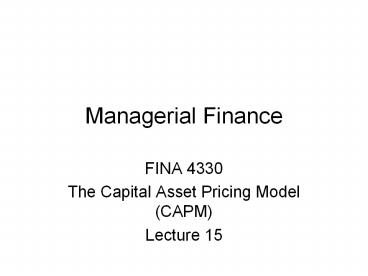Managerial Finance PowerPoint PPT Presentation
Title: Managerial Finance
1
Managerial Finance
- FINA 4330
- The Capital Asset Pricing Model (CAPM)
- Lecture 15
2
Simplifying Assumptions
- Individuals can trade securities without regard
to fees, taxes, and other frictions. - Individuals get any relevant information about
the firms they are interested in costlessly. - Individual investors can borrow or save at the
same riskless rate equal the the riskfree rate
3
Summary and Conclusions
- The contribution of a security to the risk of a
well-diversified portfolio is proportional to the
covariance of the security's return with the
markets return. This contribution is called the
beta.
- The CAPM states that the expected return on a
security is positively related to the securitys
beta
4
Estimating b with regression
Security Returns
Return on market
Ri a i biRm ei
5
Practical Issues in CAPM
- Forecasting Beta
- The problem is that you assume your estimate of
Beta is the true value of Beta - regression toward one
- Allow for extremes
- What Time Horizon
- 2 years of weekly, or 5 years of monthly
6
The Security Market Line
- Risk free interest rate?
- The Market Risk Premium
- 5.7
7
Firm valuation
- We will want to value the firm using the
Discounted Cash Flow (DCF) method. - Three issues
- What do you want to discount?
- How do you project this over time?
- How do you discount it?
8
Basic Valuation
- What do you want to Discount?
- How do you project these?
- How do you discount these?
9
Basic Valuation
- What do you want to Discount?
- Free Cash Flow
- How do you project these?
- How do you discount these?
10
Basic Valuation
- What do you want to Discount?
- Free Cash Flow
- How do you project these?
- From Historical Data
- How do you discount these?
11
Basic Valuation
- What do you want to Discount?
- Free Cash Flow
- How do you project these?
- From Historical Data
- How do you discount these?
- The Cost of Capital or (Weighted Average)
12
Free Cash Flow
- Start with EBIT
- Subtract Taxes
- Leaves EBIT(1-t) Unlevered (Operating) Net
Income - Plus Depreciation
- Less Capital Expenditures
- Less Increases in Working Capital
- Bottom Line Free Cash Flow
13
Example
- Current Sales
60 - Cost of Goods Sold
25 - Gross Profit
35 - Less Operating Expenses
9 - Less Depreciation
6 - EBIT
20 - Less Income Tax Rate (_at_ 35)
7 - Operating (Unlevered) NI
13 - Plus Depreciation 6
- Less Capital Expenditures
2 - Less Increases in Working Capital
1 - Free Cash Flow
16 -
14
Discount Rate
- Conceptually
- V Present Value of the firms Cash flows,
discounted by a number called the cost of
capital - Basically it is the IRR of the Firm.
- Conceptually, you want to discount by a rate that
reflects the risk of the firms operating Cash
Flow.
15
How do you estimate this
- Weighted Average Cost of Capital
- Once you have the stream of Cash Flows generated
by the firm, the next problem is to determine how
to discount it. - The discount rate that makes the Value of the
firm equal the firms cash flow is what we call
the Cost of Capital. - As a practical matter this can be approximated by
the Weighted Average Cost of Capital (WACC)
16
WACC
- The WACC is defined as
- rWACC rE X (E/(EDP)) rD(1-t) X (D/(EDP))
rP X (P/(EDP)) - The weighted average of the (after tax) cost of
the component securities issued by the firm,
weighted by the proportion of those securities
issued by the firm. - rE is the required return to the equity of the
firm - rD is the required return to the debt of the firm
- D is the (market value) of the debt issued by the
firm - E is the market value of the equity.
- t is the statutory tax rate.
- rP is the required return to the preferred stock
of the firm - P is the (market value) of the preferred stock
issued by the firm
17
WACC Estimation
- Some of these variables are not easily estimated
so we make some assumptions - To estimate D use the Book value of the debt.
- To estimate rD use the ratio of Total Interest
payments to the total book value of the debt - To estimate rE use the Capital Asset Pricing
Model

